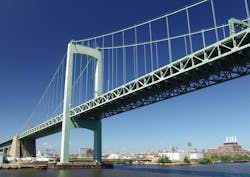Designed by renowned civil engineer Othmar Ammann and constructed by American Bridge Co., the Walt Whitman Bridge was first opened to traffic in 1957 and utilized a concrete-filled steel grid deck. The seven-lane 3,540-ft-long suspension bridge is owned and operated by the Delaware River Port Authority (DRPA) and currently carries roughly 120,000 vehicles per day on I-76 over the Delaware River between Philadelphia and New Jersey. To accommodate peak traffic during morning and afternoon rush hours, the DRPA utilizes a movable barrier on the structure to reverse traffic in the middle lane in or out of Philadelphia. The "Walt" also is the primary route for sports fans and vacationers, giving access to the Sports Complex in South Philadelphia for sporting events and the Jersey Shore during summer travel months.
After more than a half-century of heavy use the Walt Whitman Bridge was in need of repairs, so in 2010 the DRPA awarded a $128 million deck-replacement contract to American Bridge, the same company that originally built the bridge. Deck replacement did not actually begin until late 2011, as American Bridge used the first year to install a temporary work platform below the existing deck, as well as design and assemble three overhead gantry cranes (one for each span). This work platform and gantry system was necessary to overcome lane closure and work-zone restrictions imposed by the DRPA and keep traffic flowing on this important crossing. Construction staging allowed a full-time single lane closure for deck replacement throughout all phases of the project, with additional access-lane closures being permitted during off-peak hours.
The new steel grid deck filled with lightweight concrete is not only being used to save weight over the existing grid, but also is designed by AECOM & Weidlinger Associates to be a "floating deck" system which significantly reduces the number of expansion joints required. Originally located every 120 ft in the deck, 26 expansion joints have been eliminated with the new design and the only joints currently required are at the towers and anchorages. Elastomeric bearings of varying type between new stringers and existing floorbeams were used to achieve this floating deck system.
Currently in the seventh and final stage, American Bridge is well ahead of schedule and expects to wrap-up the 271,000-sq-ft redecking project later this year—ahead of the early completion date set for January 2014. Bill Batzel, field engineer for American Bridge said, "the project is going very well and we are completing one stage (one lane) about every three months. We have not encountered any significant issues installing the deck panels, however bolting the trim bars and welding the distribution bars has been a little time consuming—but is still much faster than installing a conventional CIP concrete deck." Since one lane is roughly 39,000 sq ft, American Bridge is averaging nearly 13,000 sq ft per month.



